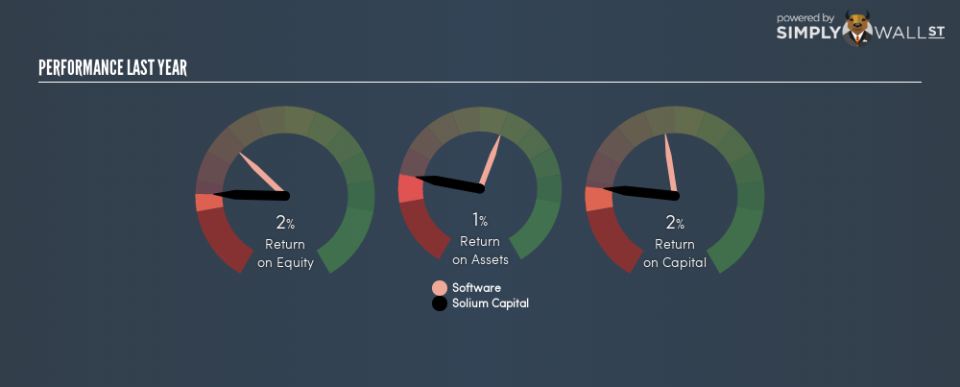How Do Solium Capital Inc.’s (TSE:SUM) Returns On Capital Compare To Peers?

Today we are going to look at Solium Capital Inc. (TSE:SUM) to see whether it might be an attractive investment prospect. In particular, we’ll consider its Return On Capital Employed (ROCE), as that can give us insight into how profitably the company is able to employ capital in its business.
Firstly, we’ll go over how we calculate ROCE. Then we’ll compare its ROCE to similar companies. Finally, we’ll look at how its current liabilities affect its ROCE.
Return On Capital Employed (ROCE): What is it?
ROCE is a measure of a company’s yearly pre-tax profit (its return), relative to the capital employed in the business. All else being equal, a better business will have a higher ROCE. Ultimately, it is a useful but imperfect metric. Author Edwin Whiting says to be careful when comparing the ROCE of different businesses, since ‘No two businesses are exactly alike.’
How Do You Calculate Return On Capital Employed?
The formula for calculating the return on capital employed is:
Return on Capital Employed = Earnings Before Interest and Tax (EBIT) ÷ (Total Assets – Current Liabilities)
Or for Solium Capital:
0.019 = US$6.8m ÷ (US$196m – US$29m) (Based on the trailing twelve months to September 2018.)
So, Solium Capital has an ROCE of 1.9%.
Check out our latest analysis for Solium Capital
Want to participate in a short research study? Help shape the future of investing tools and receive a $60 prize!
Is Solium Capital’s ROCE Good?
ROCE can be useful when making comparisons, such as between similar companies. In this analysis, Solium Capital’s ROCE appears meaningfully below the 9.0% average reported by the Software industry. This could be seen as a negative, as it suggests some competitors may be employing their capital more efficiently. Regardless of how Solium Capital stacks up against its industry, its ROCE in absolute terms is quite low (especially compared to a bank account). Readers may wish to look for more rewarding investments.
Solium Capital’s current ROCE of 1.9% is lower than 3 years ago, when the company reported a 11% ROCE. Therefore we wonder if the company is facing new headwinds.
When considering this metric, keep in mind that it is backwards looking, and not necessarily predictive. Companies in cyclical industries can be difficult to understand using ROCE, as returns typically look high during boom times, and low during busts. This is because ROCE only looks at one year, instead of considering returns across a whole cycle. Since the future is so important for investors, you should check out our free report on analyst forecasts for Solium Capital.
Do Solium Capital’s Current Liabilities Skew Its ROCE?
Short term (or current) liabilities, are things like supplier invoices, overdrafts, or tax bills that need to be paid within 12 months. Due to the way the ROCE equation works, having large bills due in the near term can make it look as though a company has less capital employed, and thus a higher ROCE than usual. To check the impact of this, we calculate if a company has high current liabilities relative to its total assets.
Solium Capital has total liabilities of US$29m and total assets of US$196m. As a result, its current liabilities are equal to approximately 15% of its total assets. This is not a high level of current liabilities, which would not boost the ROCE by much.
Our Take On Solium Capital’s ROCE
Solium Capital has a poor ROCE, and there may be better investment prospects out there. Of course, you might find a fantastic investment by looking at a few good candidates. So take a peek at this free list of companies with modest (or no) debt, trading on a P/E below 20.
If you like to buy stocks alongside management, then you might just love this free list of companies. (Hint: insiders have been buying them).
To help readers see past the short term volatility of the financial market, we aim to bring you a long-term focused research analysis purely driven by fundamental data. Note that our analysis does not factor in the latest price-sensitive company announcements.
The author is an independent contributor and at the time of publication had no position in the stocks mentioned. For errors that warrant correction please contact the editor at editorial-team@simplywallst.com.

 Yahoo Finance
Yahoo Finance 
